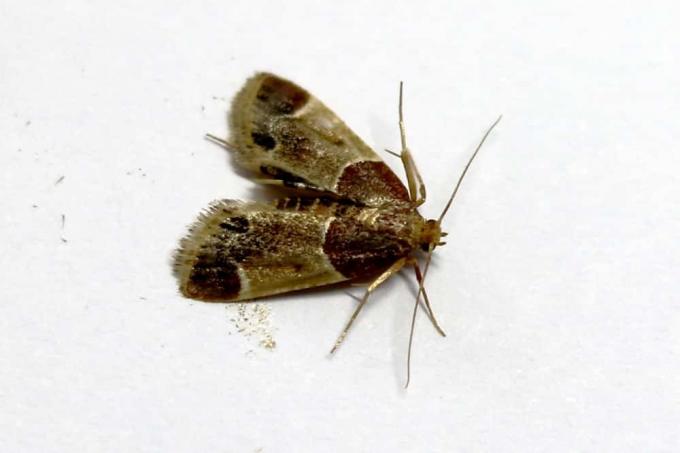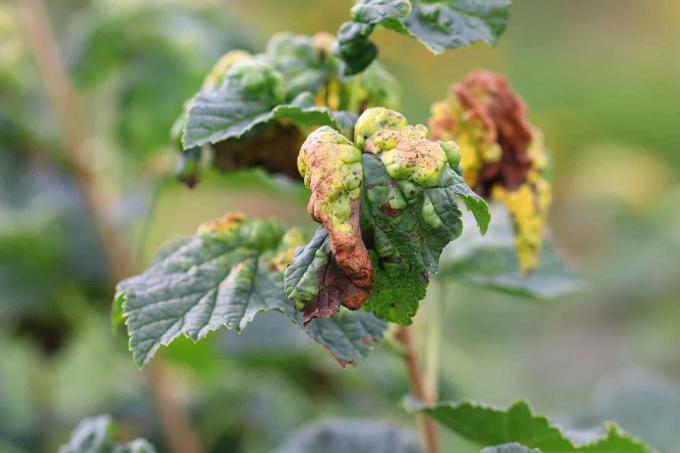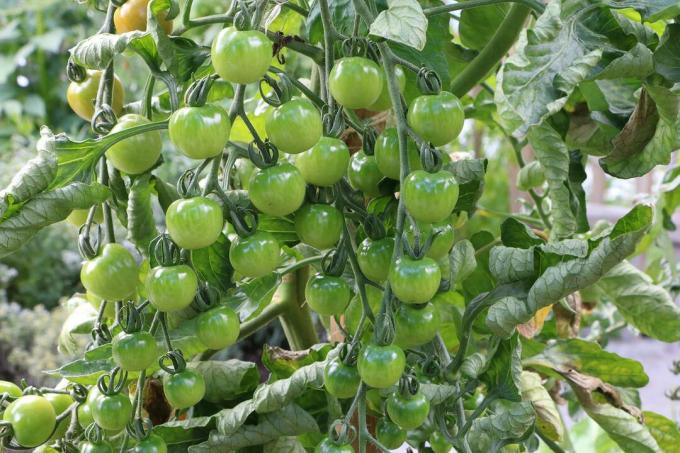

Table of contents
- The right time
- hibernation of pests
- sprouting spray
- floor spray
- Spray when infested
- rapeseed oil
- Tansy tea and vermouth tea
- horsetail and nettles
- baking soda
- soft soapy water
Fruit trees are a must in your own garden. But these trees in particular are also plagued by many pests if they are not protected. Natural pesticides are always preferable to chemical pesticides, so that consumption is harmless to health and still enjoyable. Timing is also important to protect the fruit trees well.
The right time
To prevent pests, the fruit trees should be sprayed as early as possible in the year. The first right time for this is in late winter, when the first shoots appear. Because it is precisely on these fresh, green leaves, twigs and buds that various pests like to settle. To avoid this, the entire tree is ideally treated in late winter. So the following should be considered for the right time:
- always use an overcast day
- no rain or sunshine
- The time window is very short
- from the first swelling of the buds
- depending on the weather only within two weeks
When the first small buds and leaf shoots appear, the larvae are about to hatch. During this time they are particularly susceptible and can therefore be fought well. If sprayed too early, the eggs could still be in a resting phase, so the spray used cannot harm them. If sprayed too late, the young leaves of the tree could be damaged.
Tip:
It is also helpful against pest infestation to paint the trunks of the trees white in addition to spraying them in late winter. This is a lime coating that is intended, among other things, to protect against the laying of eggs in autumn.
hibernation of pests

There are many pests that can harm the fruit tree in spring and summer. The fatal thing here is that the pests hibernate on or under the trees and are already there. Either the eggs or the larvae of the individual pests hibernate directly on the trees, in the branches, under the leaves or in the bark, but also in the ground under the tree. Here are the following pests that could attack the fruit trees because they have already survived the winter on the tree:
- Frost moth, scale insect or spider mite
- in the branches and twigs as an egg
- also in cracks or wounds of the bark
- Blood lice hibernate in the ground
Each insect lays its eggs differently. The fruit spider mites like to lay their eggs on the underside of the branches facing the sun, while the offspring of the common spider mite survive the winter in the bark.
sprouting spray
If spraying is carried out in late winter, the fruit trees should be prepared in advance. To do this, the trunks are brushed off with a hard brush. In this way, loose pieces of bark are removed; larvae or eggs could already have been deposited underneath. In this way, they can be better reached and destroyed during the spraying. This should be done as follows:
- Use backpack sprayer
- Spray trees from all sides
- Twigs, trunk and branches
- spray thoroughly
- Trees Ideally dripping wet afterwards
Tip:
Spraying should be done on a dry, overcast day. When it rains, the spray is washed away too quickly without having its full effect. If the sun shines, it dries too quickly, and young leaves could also suffer burns.
floor spray
Since larvae of pests can also hibernate in the soil, this should definitely be treated when spraying in late winter. So not only the fruit tree itself is sprayed thoroughly, but also the ground all around. Nematodes (threadworms) diluted with water can also be poured onto the earth around the tree, these are the natural enemies of larvae that hibernate in the soil but damage the fruit tree and the crop not.
Spray when infested
Was the spraying missed in late winter or are there still pests in the spring? fruit tree, then spraying should be carried out immediately in the event of an acute infestation become. For this purpose, the pests, the nests or the spider-like structures are sprayed directly with the spray agent used. Rinsing off with the hose beforehand can also be helpful. In the case of acute infestation, spraying should be repeated as often as necessary within a few days. This should be done as follows:
- use a backpack sprayer for large trees
- for small trees, a hand sprayer is sufficient
- Spray each visible infestation individually
- additionally spray the whole tree
- Repeat the spraying process after two to three days
Spraying can only be stopped when there are no more pests on the fruit tree.
Tip:
To prevent crawling pests from getting onto the fruit tree from the ground in the first place, glue rings that are attached around the trunk have also proven their worth. Crawling insects stick to it and cannot get to the flowers and leaves in the treetop.
rapeseed oil

The use of rapeseed oil for spraying is natural and, above all, non-toxic. Not only aphids, spider mites, mealybugs or scale insects can be combated with this. Winter moths, cherry fruit flies, cicadas, plum moths and white flies also don’t stand a chance when sprayed with rapeseed oil. Not only the pests themselves, but also the eggs and larvae can be fought in this way. However, rapeseed oil does not help against diseases such as scab or monilia. The following fruit trees can be protected from pests with rapeseed oil:
- berry bushes
- especially currants and gooseberries
- Pome fruit like apples or pears
- Stone fruit such as plums, cherries or apricots
If the infestation of the pests is particularly severe, other means can also be used to counteract this, which are also applied on a biological basis.
Tip:
You don't have to make the spray with rapeseed oil yourself. Ready-made mixtures or concentrates that are diluted with water are available in specialist shops.
Tansy tea and vermouth tea
If the infestation is only slight or if the spraying with rapeseed oil did not achieve the desired result because the infestation has Pests is particularly high, then spraying and watering with tansy and wormwood tea can be carried out become. It is precisely this combination that has proven effective against pest infestation on fruit trees. Because these natural remedies from plants are primarily intended to strengthen the fruit trees so that they can defend themselves against pest infestation. Because as a rule, vulnerable, not strengthened and sickly trees are unprotected from pest infestation. So that the brew can protect properly, it is used as follows:
- regularly water the fruit trees with it
- additionally spray regularly
- in this way, the plant's own defenses are vitalised
Tip:
Ready-made tea pads are available in well-stocked specialist shops and on the Internet, which only need to be brewed according to the manufacturer's instructions. This eliminates the need to search for and harvest the plants from which a brew could then be made.
horsetail and nettles

Another good home remedy, especially against aphids, is a brew made from nettles or horsetail. However, this is only helpful with a light infestation or with small trees. Horsetail and stinging nettles grow everywhere along the wayside along field or forest paths and can easily be picked here for further use. The brew is then made as follows:
- 1 kilo of plants
- to 10 liters of water
- douse with boiling water
- soak in water for several days
- use a covered pot or bucket
- until bubbles form on surface
- pour off the liquid
- mix with water
- use for spraying and watering
Tip:
If you often make a brew from these plants, you can also create a small bed in a corner of the garden with nettles and horsetail. Since these are weeds, they grow back quickly.
baking soda
A solution of baking soda works well against blood lice. If other pests are to be combated, then oils or alcohol must be added. So the solutions for spraying a light infestation on fruit trees are as follows:
- Basic recipe baking soda and water
- Half a teaspoon of baking soda per liter of water
- add a teaspoon of cooking oil
- and grate 1/4 teaspoon curd soap
- then add two teaspoons of pure alcohol
The mixture must be stirred well so that the soap is also completely dissolved. Therefore, the alcohol should only be added at the very end, otherwise it could evaporate. When the mixture is ready, it is poured undiluted into a squeeze bottle and used directly.
Tip:
Instead of pure alcohol, which is available in pharmacies, organic spirits can also be used.
soft soapy water
If there is only a small infestation, a mixture of soft soap can also be used to counteract this. However, soaps without synthetic additives should always be used. The lye is then sprayed directly onto the pest-infested areas on the fruit trees. The soft soapy water is made as follows:
- a tablespoon of soap
- to a liter of water
- add a splash of spirit
The effectiveness is further increased by the addition of alcohol.
Tip:
It is important, if the tree is sprayed well with a hose beforehand, to ensure that this is done on Evening happens when the sun has already set, otherwise the leaves will burn and Fruit. If you spray it off with water in the evening, it can dry again until the next morning.
 garden editorial
garden editorial I write about everything that interests me in my garden.
Learn more about crop protection products

Fight powdery mildew successfully | 12 remedies against powdery mildew
If the hobby gardener hears the word "mildew" the alarm bells are already ringing. Because these fungi can cause enormous damage to ornamental and useful plants. Once the plant has been infected, combating the fungus is the top priority. Here you can find out which means will help you in the fight against the whitish to greyish plaque.

Cherries: Cherry fruit fly sprays: 7 worm remedies
The cherry fruit flies cause many problems and can significantly deplete an entire year's harvest, in extreme cases even destroy it completely. So that the cherries from your own tree can ripen without maggots and taste delicious, the gardener has a number of options for combating them.

Combat pear rust: Sprays and home remedies for pear rust
pear grating. Even the name is a nightmare for owners of pear trees, because this stubborn fungal disease can weaken pears over the years and does not decrease in intensity. Nevertheless, there are some ways and means to prevent the infestation.

Sprays in viticulture
Sprays in viticulture are hardly ever used. The weed killers are pesticides and herbicides or synthetic fertilizers are used.

Leaf diseases on currants: leaf fall disease & Co
Diseases on the leaves are not uncommon in currants. They are triggered by fungi, viruses or various pests settle in. Many problems can be remedied with simple home remedies. Proper care also helps to prevent many diseases.

Fertilize tomatoes: how often, when and with what?
Tomatoes need a consistently high amount of nutrients for the development of flowers and fruits. In addition to choosing the right fertilizer, the amount and frequency also play an important role. All essential information for an optimal dosage can be found here.



